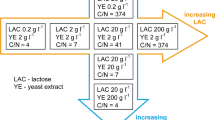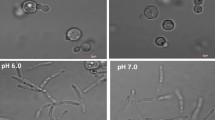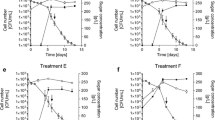Abstract
Debaryomyces hansenii exhibited yeast-to-mycelium dimorphism in the continuous fermentation of xylose-containing media made from acid hydrolyzates of barley bran. The lower the dilution rate, the earlier the yeast-to-mycelia transition occurred. Within a selected range of dilution rates, the yeast morphology was reversibly affected by the dissolved O2: low aeration caused the transition from oval cells to hyphae, and further increases in dissolved O2 concentration resulted in recuperation of the oval shape. Under the operational conditions assayed, xylitol was the major fermentation product when the yeast was in both morphological forms, whereas the production of ethanol was increased when the yeast grew under hyphal morphology and oxygen limitation. The lower xylose consumption corresponded to the yeast-to-mycelia transition. In media made with commercial sugars (xylose or glucose), the yeast-to-mycelia transition was induced by adding selected amounts of acid-soluble lignin.
Similar content being viewed by others
References
Cruz JM, Domínguez JM, Domínguez H, Parajó JC (1999) Solvent extraction of hemicellulosic wood hydrolysates: a procedure useful for obtaining both detoxified fermentation media and polyphenols with antioxidant activity. Food Chem. 67: 147–153.
Gírio FM, Roseiro JC, Sá-Machado P, Duarte-Reis AR, Amaral-Collaço ZMT (1994) Effect of oxygen transfer rate on levels of key enzymes of xylose metabolism in Debaryomyces hansenii. Enzyme Microbiol. Technol. 16: 1074–1078.
Hill GA, Robinson CW (1988) Morphological behaviour of Saccharomyces cerevisiae during continuous fermentation. Biotechnol. Lett. 10: 815–820.
Johnson BF, McDonald IJ (1983) Cell division: a separable cellular sub-cycle in the fission yeast Schizosaccharomyces pombe. J. General Microbiol. 129: 3411–3419.
Liu T, Yu D (1993) Morphological measurements on Penicullium chrysogenum broths by rheology and filtration methods. Biotechnol. Bioeng. 42: 777–784.
McCarthy A, O'Shea DG, Murray NT, Walsh PK, Foley G (1988) Effect of cell morphology on dead-end filtration of the dimorphic yeast Kluyveromyces marxianus var. marxianus NRRLy2415. Biotechnol. Prog. 14: 279–285.
McNeil B, Kristiansen B, Seviour RJ (1989) Polysaccharide production and morphology of Aureobasidium pullulans in continuous culture. Biotechnol. Bioeng. 33: 1210–1212.
O'Shea DG, Walsh PK (1996) Morphological characterization of the dimorphic yeast Kluyveromyces marxianus var. marxianus NRRLy2415 by semi-automated image analysis. Biotechnol. Bioeng. 51: 679–690.
Parajó JC, Domínguez H, Domínguez JM (1997a) Improved xylitol production with Debaryomyces hansenii Y-7426 from raw or detoxified wood hydrolysates. Enzyme Microbiol. Technol. 21: 18–24.
Parajó JC, Domínguez H, Domínguez JM (1997b) Xylitol production from Eucalyptus wood hydrolysates extracted with organic solvents. Process Biochem. 32: 599–604.
Peng CC, Chen TL (1994) Influence of n-hexadecane on penicillin fermentation with Penicillium chrysogenum: the morphological effect. Biotechnol. Tech. 8: 773–778.
Pepper T, Olinger PM(1988) Xylitol in sugar-free confections. Food Technol. 42: 98–106.
Pons MN, Vivier H, Rémy JF, Dodds JA (1993) Morphological characterization of yeast by image analysis. Biotechnol. Bioeng. 42: 1352–1359.
Rodríguez C, Domínguez A (1984) The growth characteristics of Saccharomycopsis lipolytica: morphology and induction of mycelium formation. Can. J. Microbiol. 30: 605–612.
San-Blas G, Padrón R, Alamo L, San-Blas F (1997) Use of morphology index histograms to quantify populations of the fungal pathogen Paracoccidioides brasiliensis. Microbiology 143: 197–202.
Sipiczki M, Takeo K, Grallert A (1998) Growth polarity transitions in a dimorphic fission yeast. Microbiology 144: 3475–3485.
Walker GM, Sullivan PA, Shepherd MG (1984) Magnesium and the regulation of germ-tube formation in Candida albicans. Microbiology 130: 1941–1945.
Warren SJ, Keshavarz-Moore E, Ayazi Shamlou P, Lilly MD, Thomas CR, Dixon K (1995) Rheologies and morphologies of three Actinomycetes in submerged culture. Biotechnol. Bioeng. 45: 80–85.
Ylikahri R (1979) Metabolic and nutritional aspects of xylitol. In: Chichester CO, Mrak EM, Stewart GF eds. Advances in Food Research, Vol. 25. New York, NY: Academic Press, pp. 159–180.
Author information
Authors and Affiliations
Rights and permissions
About this article
Cite this article
Cruz, J., Domínguez, J., Domínguez, H. et al. Dimorphic behaviour of Debaryomyces hansenii grown on barley bran acid hydrolyzates. Biotechnology Letters 22, 605–610 (2000). https://doi.org/10.1023/A:1005677618040
Issue Date:
DOI: https://doi.org/10.1023/A:1005677618040




